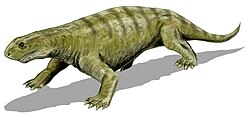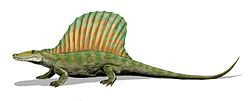| Ianthodon Temporal range: Pennsylvanian, ~ | |
|---|---|
 | |
| I. schultzei cranial and skeletal reconstruction | |
| Scientific classification | |
| Domain: | Eukaryota |
| Kingdom: | Animalia |
| Phylum: | Chordata |
| Clade: | Synapsida |
| Clade: | Eupelycosauria |
| Clade: | Metopophora |
| Clade: | Haptodontiformes |
| Genus: | † Ianthodon Kissel & Reisz, 2004 |
| Type species | |
| †Ianthodon schultzei Kissel & Reisz, 2004 | |

Ianthodon is an extinct genus of basal haptodontiform synapsids from the Late Carboniferous about 304 million years ago. The taxon was discovered and named by Kissel & Reisz in 2004. [1] The only species in the taxon, Ianthodon schultzei, was found by separating it from a block that also contained the remains of Petrolacosaurus and was initially thought to contain elements of Haptodus . The evolutionary significance of the taxon was not realized until a publication in 2015. [2] The fossil of this organism was discovered in Garnett, Kansas. [2]





